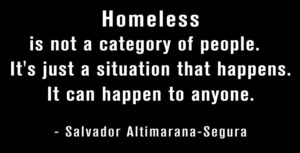January 5, 2021 at 8:53 pm

A food pantry is what it is because of three things:
the economic situation at the moment
the volunteers
the people who shop there.
The people come together looking for groceries but often, they want and need far more.
While the coronavirus pandemic rages, the food pantry lines get longer every pantry day because people, families, deal with change they didn’t ask for.
In short, they are rewriting their destiny stories without a road map or instructions.
A number of the people in the pantry, both shoppers and volunteers, didn’t know about food pantries until circumstances set up a situation where they suddenly looked around a room and realized where they were.
There is a name for their category – SITUATIONAL POOR.
A person fits into the situational poor category when s/he lands in a situation created by an event such as a hurricane, fire, floor, pandemic, or other disaster which destroys the home, car, job.
Pantries offer much – peace, community, spiritual connection, groceries. I always think of a food pantry in the basement of a church as a cross between a church service and a busy pizza place.
A food pantry, and those connected with it, are not a program. They are a community. As volunteers, all we really do is open the door. As all the hungry people walk through the door, they undergo a change somehow.
Each person in a pantry, in whatever capacity, has experienced rejection in some way – too young, too old, too crazy, too sick, too poor, not poor enough.
The food pantry experience does not heal a person, nor does it change the story.
The food pantry experience does not offer therapy.
The food pantry is, instead, a conduit for each person’s own healing.
FOOD PANTRY RULES
Sign your name in the register as you enter the pantry.
Find a place in line.
Do not crowd or block the door to the pantry room.
No more than 2 shoppers are allowed in the pantry at one time.
No more than one new shopper is allowed in the pantry at one time.
Shop for a three-day supply of food for everyone in your household.
Place your selections on the table as you shop.
Respect the restrictions on certain foods.
Finish your shopping in 10 minutes.
Once you begin to bag your groceries, do not continue to shop.
Because the food availability is different each time you shop, it is best to visit the food pantry weekly.
Thank you.
Thurman Greco
P.S. The rules may be different at the pantry where you shop. Each food pantry is different. The space is different. The times the pantry is open is different. The management is different.
These specific rules were used in the food pantry I managed where the people were many, the space small, and the hours few.
Please forward this article to your preferred social media network.
Share it with your friends.




November 10, 2015 at 7:48 am

“Homeless is not a category of people. It’s just a situation that happens. It can happen to anyone.” – Salvador Altamirano-Segura
The homeless have problems just like you and me:
employment
health issues
disabilities
domestic violence
veterans
THEY JUST DON’T HAVE A ROOF OVER THEIR HEADS.
Homeless people, families enter food pantries very quietly. They’ve lost their voices. The goal is to melt into the background, get food, and disappear.
There is an exception to the voicelessness when the person communicates with beings unknown to the rest of us in tongues we don’t understand. One shopper I know has been in another world since before I began working in the pantry in 2005.
We can all help the homeless in some way. Each of us has talents and skills which can be useful.
1. DONATE. Homeless people carry their kitchens in their pockets so a lot of food which we take for granted and use is just not helpful. Important in the homeless diet is:
peanut butter and crackers
cereal in small packages
fruits and vegetables which can be eaten raw
milk in small containers.
Give throughout the year by regularly donating to a food pantry in your area which is most homeless friendly.
2. VOLUNTEER. Pantries everywhere need an extra set of hands to:
Answer mail
Drive a truck
Serve food
Clean up at closing time
Send press releases
Hold food drives
Straighten shelves
Deliver food to the home bound
3. CLEAN OUT YOUR CLOSETS. Donate clothing, bedding, books, in good condition to places where the homeless will have access to your gently used items.
4. SHARE. Do you or does someone you know have a garden? Donate the excess to a homeless friendly pantry or soup kitchen in your area. When your garden tomatoes get to be too plentiful, there are those in your area who need the food. Donate, don’t dump.
5. PUSH THE ENVELOPE. Contact elected officials about homeless issues in your area. Encourage them to make ending homelessness important in your community.
6. EDUCATE YOURSELF. Returning veterans have special needs. For one thing, they often begin their separation from the military homeless.
7. FIND A JOB. Encourage your church or community to hire a homeless person. Many homeless want to work, have skills, but have trouble finding regular employment.
8. TEACH. Do you have a skill to share? Contact a local shelter and offer to give classes.
Thank you for reading this blog/book.
The stories are true. The people are real.
Please share this article with your preferred social media network. And send it to anyone you know who might be interested.
Don’t forget to join the email list.
Artwork for this article was donated by Jennette Nearhood
Thurman Greco
June 16, 2015 at 6:23 am

Many people coming to a pantry or soup kitchen have given up on their stories. They’ve lost their voices. With trauma-sensitive yoga classes, they have an opportunity to change the stories themselves. They can add new chapters.
Tara Sanders, a Woodstock based yoga instructor, is the program director in the nonprofit Exhale to Inhale.
Exhale to Inhale yoga works to empower survivors of domestic violence and sexual assault to heal through yoga. Exhale to Inhale yoga guides women through postures, breathing, and meditation. Taught in trauma-sensitive style, practitioners are enabled to ground themselves in
their bodies
their strength
their stillness.
As this happens, they connect to themselves and work toward empowerment and worthiness. This practice can be transformational for survivors of sexual abuse and domestic violence when they shed the cloak of victimhood.
This is extremely important for people working and shopping in pantries because many survivors of domestic and sexual violence are found in these communities. The influence of this trauma is great. Add to this trauma another layer of
hunger,
unemployment,
underemployment,
homelessness,
serious illnesses to include mental illness
and you have a person who is finally voiceless.
Finally, the classes are free. Many attending these classes have absolutely no money at all.
Healers and body workers have long known that when the body is traumatized, the event is stored in the muscles.
Tara teaches the classes without music. She does not touch the students to correct a posture. Lights remain on throughout the class. These sessions offer survivors an opportunity to reclaim their lives through the healing and grounding of yoga.
Tara uses the yoga classes to help her students feel safe, strong, and in the present moment. As she teaches, she is a conduit for healing, and healthful programs in our community.
Exhale to Inhale is a New York-based nonprofit offering free weekly yoga classes to survivors of domestic and sexual assault. As an introduction to our area, Tara will teach free public yoga classes on Saturdays from 11 am to noon at the Center for Creative Education, 15 Railroad Ave, in Kingston.
After June 20, Exhale to Inhale yoga will be offered free of charge to women in area shelters.
http://www.exhaletoinhale.org
http://www.traumacenter.org
http://www.cce4me.org
Thanks for reading this blog.
Please send a comment.
Please refer this article to your preferred social media network.
Don’t forget to join the email list.
Thurman Greco












